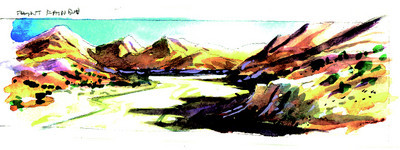Rainbow Basin Natural Area provides recreation, unique geology

A splendid cool season destination, Rainbow Basin Natural Area north of Barstow, Calif., offers high-desert camping, picnicking, hiking, horseback riding, scenic touring, wildlife watching and plenty of photo opportunities. This spring it may also offer a bonus with a fair showing of wildflowers.
Administered by the Bureau of Land Management as an area of critical environmental concern, Rainbow Basin protects unique geology and extensive fossil beds. Named for multi-colored rock formations and mineralized earth exposed by erosion in several scenic canyons, Rainbow Basin lies 165 miles from Las Vegas. The area includes both public lands and private in-holdings, such as land owned by the Southern Pacific Railroad, various mining interests and local ranchers with grazing rights.
To reach Rainbow Basin, follow Interstate 15 south to Barstow. From Barstow’s Main Street, head north on First Avenue. Watch for Irwin Road and turn left. Proceed on Irwin Road until you see the Rainbow Basin sign, where you turn left on Fossil Bed Road, a gravel route. Follow this road a couple of miles west into the natural area.
Rainbow Basin lies just eight miles from Barstow, but seems a world away. Unpaved side roads access both Owl Canyon Campground and the popular one-way loop road through Fossil Canyon, a four-mile drive. This twisting dirt loop road requires vehicles with some clearance, such as trucks or SUVs. Drivers of large recreational vehicles, motor homes or vehicles towing trailers should stay off the loop with its narrow places and tight curves. Red markers designate old roads now closed to travel. Brown markers indicate routes open for exploration.
One of several small canyons in the natural area with gravelly washes, eroded walls and vegetation, Owl Canyon lends its name to the campground developed nearby. Open all year, the facility contains 31 sites with parking pads, tables, fire pits or barbecues and centrally located restrooms, all handicapped accessible. Available on a first-come basis, campsites cost $6 per night. Plan for an early arrival on weekends or holidays or visit mid-week for best site selection. Campers should bring enough water from home for drinking and camp use. When water is available, it must be trucked to the site. Recent vandalism rendered the tanks unusable until they are repaired.
To protect native habitat, the BLM prohibits motorized vehicles in the washes in Owl, Coon and Fossil canyons. These interesting canyons invite exploration on foot or horseback and provide photographers with varied subjects. Because of their vegetation, the presence of occasional water and the protective cliffs, the canyons attract a wide variety of wild animals and birds best observed or photographed early or late in the day.
Watch for spring wildflowers along the loop route and in or near the canyons. They appear first on south-facing slopes. Early indicators point to scattered wildflower shows this spring, following enough rain in November and December to start seeds sprouting. Follow-up rains this winter may be enough, barring too much wind, to encourage blossoming. If conditions continue to be favorable, wildflowers should peak in March or early April, depending on elevation. Just in case, take plenty of film on outings this spring.
The Fossil Canyon Loop reaches areas where erosion continually exposes fossils deposited over millions of years on the bottom of a vast lake. Trapped in the rock-hard mud, multitudes of aquatic creatures from ages past survive as fossils. Additionally, the fossilized remains include ancient land animals from times when grassy plains bordered the lake. Occasionally mired and drowned, creatures like camels, mastodons, three-toed horses, rhinoceros and saber-toothed cats added their bones to the fossil record.
An illustrated field guide helps you identify the fossils you see. Leave the fossils for others to observe. You must have a permit to collect fossils in Rainbow Basin. Frequently, the area provides open-air classrooms for teachers, professors and students enjoying field study of paleontology and geology.
Margo Bartlett Pesek’s column appears on Sundays.












